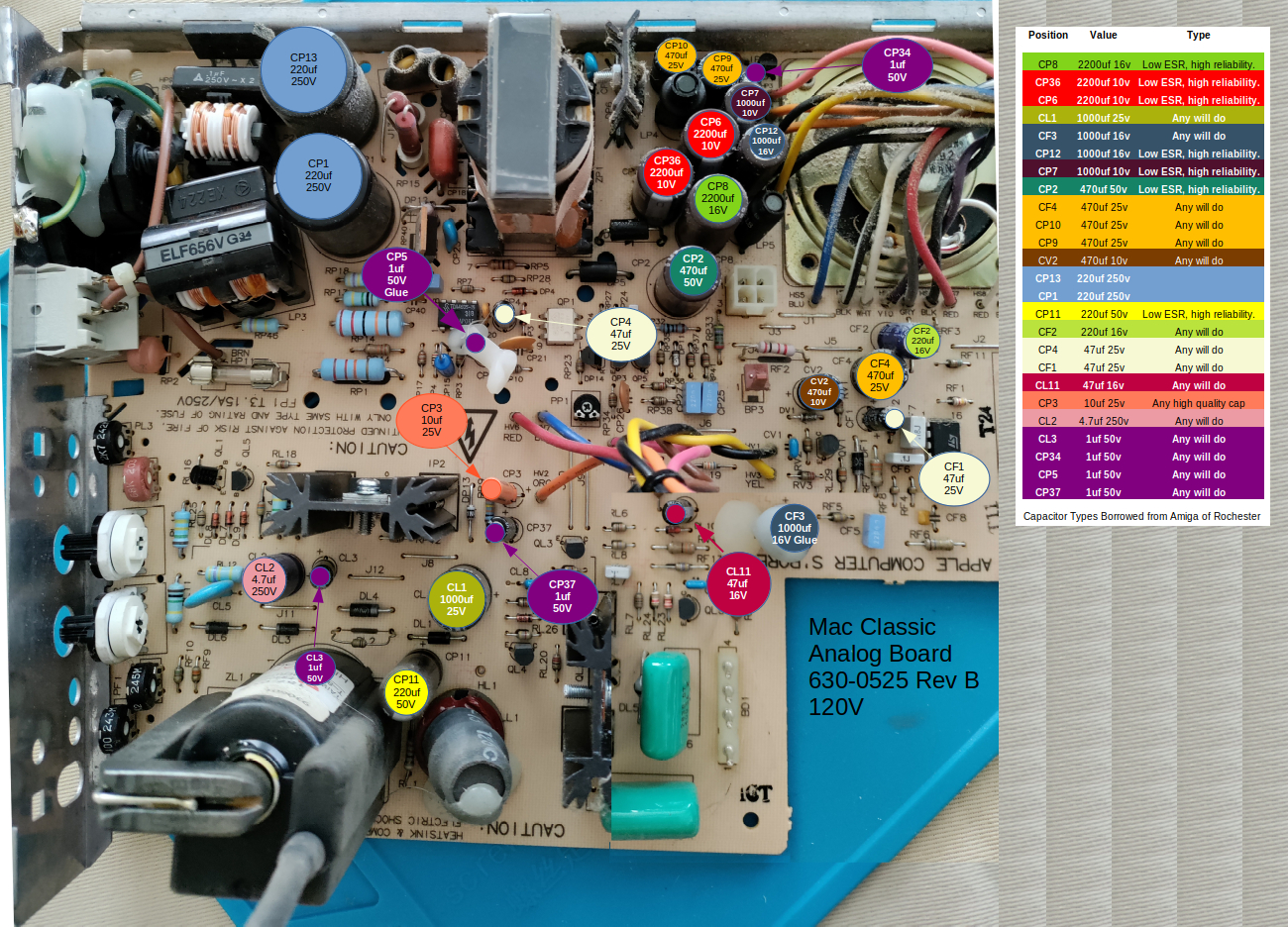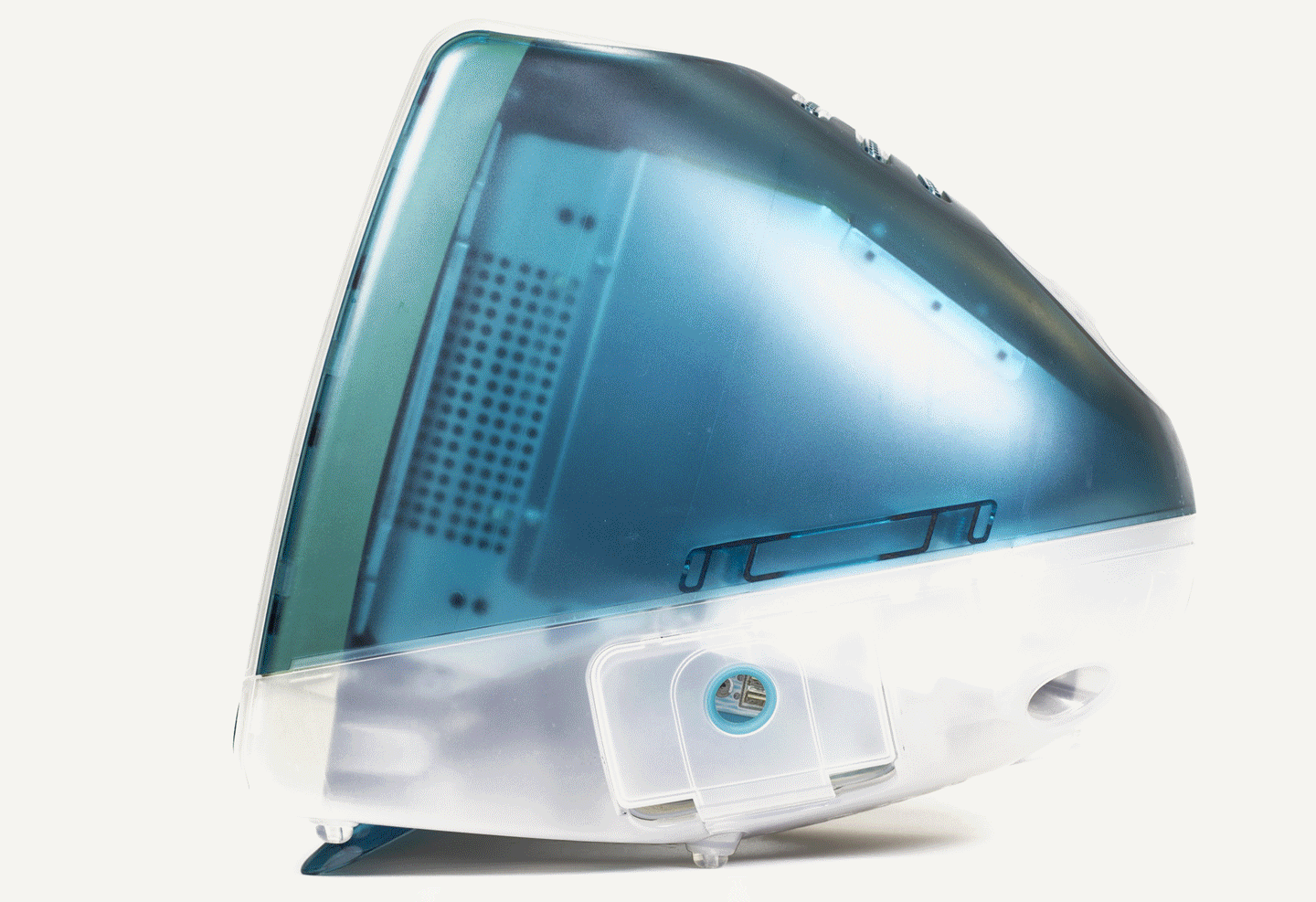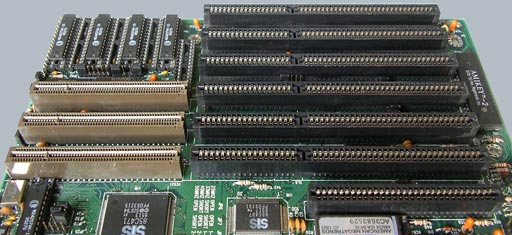|
Analog Board
An analog board is a circuit board that contains the majority of analog circuitry in certain Apple Macintosh computers. The analog board was one of two circuit boards within many early Macintosh computers, including the Macintosh 128K/ 512K/Plus, Macintosh SE series, and Macintosh Classic series. The analog board contained several capacitors, a battery compartment, and some other analog circuitry. Some later all-in-one Macintosh computers also included analog boards, with the most recent being the iMac G3 and eMac. In these computers, the analog board functioned as the power supply to other parts within the system, and also functioned to control the CRT display within the computer. The other board was the logic board, which contained all of the computer's digital logic circuitry, such as the processor and memory. See also * Logic board A motherboard (also called mainboard, main circuit board, mb, mboard, backplane board, base board, system board, logic board (only in Appl ... [...More Info...] [...Related Items...] OR: [Wikipedia] [Google] [Baidu] |
Apple Macintosh
The Mac (known as Macintosh until 1999) is a family of personal computers designed and marketed by Apple Inc. Macs are known for their ease of use and minimalist designs, and are popular among students, creative professionals, and software engineers. The current lineup includes the MacBook Air and MacBook Pro laptops, as well as the iMac, Mac Mini, Mac Studio and Mac Pro desktops. Macs run the macOS operating system. The first Mac was released in 1984, and was advertised with the highly-acclaimed "1984" ad. After a period of initial success, the Mac languished in the 1990s, until co-founder Steve Jobs returned to Apple in 1997. Jobs oversaw the release of many successful products, unveiled the modern Mac OS X, completed the 2005-06 Intel transition, and brought features from the iPhone back to the Mac. During Tim Cook's tenure as CEO, the Mac underwent a period of neglect, but was later reinvigorated with the introduction of popular high-end Macs and the ongoing A ... [...More Info...] [...Related Items...] OR: [Wikipedia] [Google] [Baidu] |
Macintosh 128K
The Apple Macintosh—later rebranded as the Macintosh 128K—is the original Apple Macintosh personal computer. It played a pivotal role in establishing desktop publishing as a general office function. The motherboard, a CRT monitor, and a floppy drive were housed in a beige case with integrated carrying handle; it came with a keyboard and single-button mouse. It sold for . The Macintosh was introduced by a television commercial entitled "1984" shown during Super Bowl XVIII on January 22, 1984 and directed by Ridley Scott. Sales of the Macintosh were strong from its initial release on January 24, 1984, and reached 70,000 units on May 3, 1984. Upon the release of its successor, the Macintosh 512K, it was rebranded as the Macintosh 128K. The computer's model number was M0001. Development 1978–1984: Development In 1978 Apple began to organize the Apple Lisa project, aiming to build a next-generation machine similar to an advanced Apple II or the yet-to-be-introduced IBM ... [...More Info...] [...Related Items...] OR: [Wikipedia] [Google] [Baidu] |
Macintosh 512K
The Macintosh 512K is a personal computer that was designed, manufactured and sold by Apple Computer from September 1984 to April 1986. It is the first update to the original Macintosh 128K. It was virtually identical to the previous Macintosh, differing primarily in the amount of built-in random-access memory. The increased memory turned the Macintosh into a more business-capable computer and gained the ability to run more software. It is the earliest Macintosh model that can be used as an AppleShare server and, with a bridge Mac, communicate with modern devices. The Mac 512K originally shipped with Macintosh System 1.1 but was able to run all versions of Mac OS up to System 4.1. It was replaced by the Macintosh 512Ke and the Macintosh Plus. All support for the Mac 512K was discontinued on September 1, 1998. Features Processor and memory Like the Macintosh 128K before it, the 512K contained a Motorola 68000 connected to 512 KB of DRAM by a 16-bit data bus. Though ... [...More Info...] [...Related Items...] OR: [Wikipedia] [Google] [Baidu] |
Macintosh Plus
The Macintosh Plus computer is the third model in the Macintosh line, introduced on January 16, 1986, two years after the original Macintosh and a little more than a year after the Macintosh 512K, with a price tag of US$2,599. As an evolutionary improvement over the 512K, it shipped with 1 MB of RAM standard, expandable to 4 MB, and an external SCSI peripheral bus, among smaller improvements. Originally, the computer's case was the same beige color as the original Macintosh, Pantone 453; however, in 1987, the case color was changed to the long-lived, warm gray "Platinum" color. It is the earliest Macintosh model able to run System Software 5, System 6, and System 7. Overview Bruce Webster of ''BYTE'' reported a rumor in December 1985: "Supposedly, Apple will be releasing a Big Mac by the time this column sees print: said Mac will reportedly come with 1 megabyte of RAM ... the new 128K-byte ROM ... and a double-sided (800K bytes) disk drive, all in the standard Mac ... [...More Info...] [...Related Items...] OR: [Wikipedia] [Google] [Baidu] |
Macintosh SE
The Macintosh SE is a personal computer designed, manufactured, and sold by Apple Computer, from March 1987 to October 1990. It marked a significant improvement on the Macintosh Plus design and was introduced by Apple at the same time as the Macintosh II. The SE retains the same Compact Macintosh form factor as the original Macintosh computer introduced three years earlier and uses the same design language used by the Macintosh II. An enhanced model, the SE/30, was introduced in January 1989; sales of the original SE continued. The Macintosh SE was updated in August 1989 to include a SuperDrive, with this updated version being called the "Macintosh SE FDHD" and later the "Macintosh SE SuperDrive". The Macintosh SE was replaced with the Macintosh Classic, a very similar model which retained the same central processing unit and form factor, but at a lower price point. Overview The Macintosh SE was introduced at the AppleWorld conference in Los Angeles on March 2, 1987. The " ... [...More Info...] [...Related Items...] OR: [Wikipedia] [Google] [Baidu] |
Macintosh Classic
The Macintosh Classic is a personal computer designed, manufactured and sold by Apple Computer from October 1990 to September 1992. It was the first Macintosh to sell for less than US$1,000. Production of the Classic was prompted by the success of the original Macintosh 128K, then the Macintosh Plus, and finally the Macintosh SE. The system specifications of the Classic are very similar to those of its predecessors, with the same monochrome CRT display, 512 × 342 pixel resolution, and 4megabyte (MB) memory limit of the older Macintosh computers. Apple's decision to not update the Classic with newer technology such as a newer CPU, higher RAM capacity or color display resulted in criticism from reviewers, with ''Macworld'' describing it as having "nothing to gloat about beyond its low price" and "unexceptional". However, it ensured compatibility with the Mac's by-then healthy software base, as well as enabled it to sell for the lower price, as planned. The Classic also fea ... [...More Info...] [...Related Items...] OR: [Wikipedia] [Google] [Baidu] |
IMac G3
The iMac G3, originally released as the iMac, is a series of Macintosh personal computers sold by Apple Computer from 1998 to 2003. The iMac was the first major new product release for Apple under Steve Jobs, Apple's interim CEO and cofounder, who returned to the financially troubled company in 1996 after eleven years away. Jobs reorganized the company and simplified the product line; the iMac was designed to be Apple's new consumer desktop product, a cheaper computer for average consumers that would easily connect to the internet. Head of design Jony Ive and his team developed a teardrop-shaped, translucent plastic case for the iMac, a radical departure from the look of previous personal computers. They developed new work methodologies to finish the computer in an accelerated timeframe, and created new workflows they would use for designing products going forward. The iMac eschewed legacy technologies like serial ports and floppy disk drives for CD-ROMs and USB ports. Whi ... [...More Info...] [...Related Items...] OR: [Wikipedia] [Google] [Baidu] |
EMac
The eMac (short for education Mac) is a discontinued all-in-one Macintosh desktop computer that was produced and designed by Apple Computer Released in 2002, it was originally aimed at the education market, but was later made available as a cheaper mass-market alternative to Apple's second-generation LCD iMac G4. The eMac was pulled from retail on October 12, 2005, and was again sold exclusively to educational institutions thereafter. It was discontinued by Apple on July 5, 2006, and replaced by a cheaper, low-end iMac G5 that, like the eMac, was exclusively sold to educational institutions. The eMac design closely resembles the first-generation iMac, though the eMac is white, slightly larger in size, and heavier than the preceding G3, weighing .The unique shape of the computer was also similar to the 17-inch CRT Studio Display from 2000 (the last standalone CRT monitor Apple made). The Apple eMac features a PowerPC 7450 (G4e) processor that is significantly faster tha ... [...More Info...] [...Related Items...] OR: [Wikipedia] [Google] [Baidu] |
Logic Board
A motherboard (also called mainboard, main circuit board, mb, mboard, backplane board, base board, system board, logic board (only in Apple computers) or mobo) is the main printed circuit board (PCB) in general-purpose computers and other expandable systems. It holds and allows communication between many of the crucial electronic components of a system, such as the central processing unit (CPU) and memory, and provides connectors for other peripherals. Unlike a backplane, a motherboard usually contains significant sub-systems, such as the central processor, the chipset's input/output and memory controllers, interface connectors, and other components integrated for general use. ''Motherboard'' means specifically a PCB with expansion capabilities. As the name suggests, this board is often referred to as the "mother" of all components attached to it, which often include peripherals, interface cards, and daughterboards: sound cards, video cards, network cards, host bus adapters, TV t ... [...More Info...] [...Related Items...] OR: [Wikipedia] [Google] [Baidu] |
Mac Analog Board 630-0525 Rev B With Key
Mac or MAC most commonly refers to: * Mac (computer), a family of personal computers made by Apple Inc. * Mackintosh, a raincoat made of rubberized cloth * A variant of the word macaroni, mostly used in the name of the dish mac and cheese * Mac, Gaelic for "son", a prefix to family names often appearing in Gaelic names Mac or MAC may also refer to: Arts, entertainment, and media Fictional entities * Mac (''Green Wing''), a television character * Mac (''It's Always Sunny in Philadelphia''), a television character * Mac Gargan, an enemy of Spider-Man * Mac Foster, a character on ''Foster's Home for Imaginary Friends'' * Angus "Mac" MacGyver, from the television series ''MacGyver'' * Cindy "Mac" Mackenzie, from the TV series ''Veronica Mars'' * Lt. Col. Sarah MacKenzie, from the TV series ''JAG'' * Dr. Terrence McAfferty, from Robert Muchamore's ''CHERUB'' and ''Henderson's Boys'' novel series * "Mac" McAnnally, in ''The Dresden Files'' series * Randle McMurphy, in the movi ... [...More Info...] [...Related Items...] OR: [Wikipedia] [Google] [Baidu] |
Logic Board
A motherboard (also called mainboard, main circuit board, mb, mboard, backplane board, base board, system board, logic board (only in Apple computers) or mobo) is the main printed circuit board (PCB) in general-purpose computers and other expandable systems. It holds and allows communication between many of the crucial electronic components of a system, such as the central processing unit (CPU) and memory, and provides connectors for other peripherals. Unlike a backplane, a motherboard usually contains significant sub-systems, such as the central processor, the chipset's input/output and memory controllers, interface connectors, and other components integrated for general use. ''Motherboard'' means specifically a PCB with expansion capabilities. As the name suggests, this board is often referred to as the "mother" of all components attached to it, which often include peripherals, interface cards, and daughterboards: sound cards, video cards, network cards, host bus adapters, TV t ... [...More Info...] [...Related Items...] OR: [Wikipedia] [Google] [Baidu] |
Macintosh Computers
The Mac (known as Macintosh until 1999) is a family of personal computers designed and marketed by Apple Inc. Macs are known for their ease of use and minimalist designs, and are popular among students, creative professionals, and software engineers. The current lineup includes the MacBook Air and MacBook Pro laptops, as well as the iMac, Mac Mini, Mac Studio and Mac Pro desktops. Macs run the macOS operating system. The Macintosh 128K, first Mac was released in 1984, and was advertised with the highly-acclaimed 1984 (advertisement), "1984" ad. After a period of initial success, the Mac languished in the 1990s, until co-founder Steve Jobs returned to Apple in 1997. Jobs oversaw the release of many successful products, unveiled the modern Mac OS X, completed the Mac transition to Intel processors, 2005-06 Intel transition, and brought features from the iPhone back to the Mac. During Tim Cook's tenure as CEO, the Mac underwent a period of neglect, but was later reinvigorated w ... [...More Info...] [...Related Items...] OR: [Wikipedia] [Google] [Baidu] |










